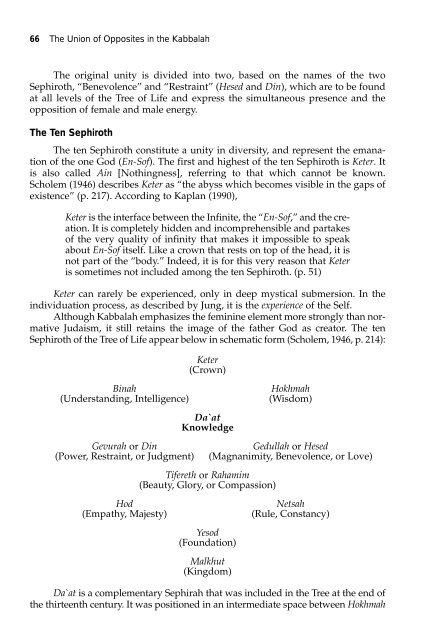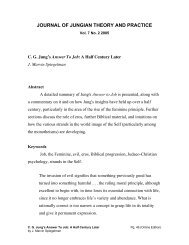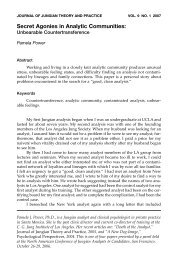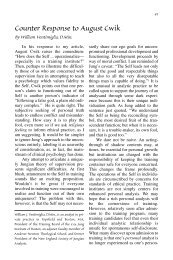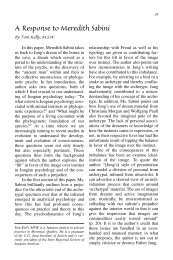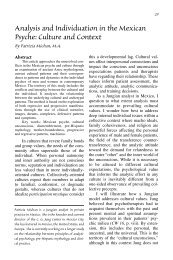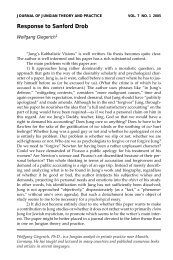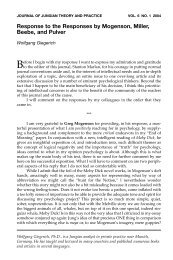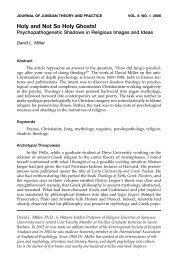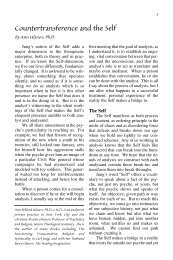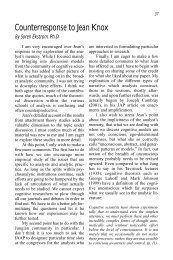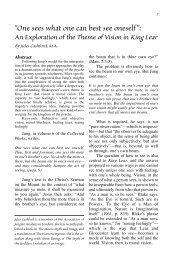The Union of Opposites in the Kabbalah - The new Israeli Jungian ...
The Union of Opposites in the Kabbalah - The new Israeli Jungian ...
The Union of Opposites in the Kabbalah - The new Israeli Jungian ...
Create successful ePaper yourself
Turn your PDF publications into a flip-book with our unique Google optimized e-Paper software.
66 <strong>The</strong> <strong>Union</strong> <strong>of</strong> <strong>Opposites</strong> <strong>in</strong> <strong>the</strong> <strong>Kabbalah</strong><br />
<strong>The</strong> orig<strong>in</strong>al unity is divided <strong>in</strong>to two, based on <strong>the</strong> names <strong>of</strong> <strong>the</strong> two<br />
Sephiroth, “Benevolence” and “Restra<strong>in</strong>t” (Hesed and D<strong>in</strong>), which are to be found<br />
at all levels <strong>of</strong> <strong>the</strong> Tree <strong>of</strong> Life and express <strong>the</strong> simultaneous presence and <strong>the</strong><br />
opposition <strong>of</strong> female and male energy.<br />
<strong>The</strong> Ten Sephiroth<br />
<strong>The</strong> ten Sephiroth constitute a unity <strong>in</strong> diversity, and represent <strong>the</strong> emanation<br />
<strong>of</strong> <strong>the</strong> one God (En-S<strong>of</strong>). <strong>The</strong> first and highest <strong>of</strong> <strong>the</strong> ten Sephiroth is Keter. It<br />
is also called A<strong>in</strong> [Noth<strong>in</strong>gness], referr<strong>in</strong>g to that which cannot be known.<br />
Scholem (1946) describes Keter as “<strong>the</strong> abyss which becomes visible <strong>in</strong> <strong>the</strong> gaps <strong>of</strong><br />
existence” (p. 217). Accord<strong>in</strong>g to Kaplan (1990),<br />
Keter is <strong>the</strong> <strong>in</strong>terface between <strong>the</strong> Inf<strong>in</strong>ite, <strong>the</strong> “En-S<strong>of</strong>,” and <strong>the</strong> creation.<br />
It is completely hidden and <strong>in</strong>comprehensible and partakes<br />
<strong>of</strong> <strong>the</strong> very quality <strong>of</strong> <strong>in</strong>f<strong>in</strong>ity that makes it impossible to speak<br />
about En-S<strong>of</strong> itself. Like a crown that rests on top <strong>of</strong> <strong>the</strong> head, it is<br />
not part <strong>of</strong> <strong>the</strong> “body.” Indeed, it is for this very reason that Keter<br />
is sometimes not <strong>in</strong>cluded among <strong>the</strong> ten Sephiroth. (p. 51)<br />
Keter can rarely be experienced, only <strong>in</strong> deep mystical submersion. In <strong>the</strong><br />
<strong>in</strong>dividuation process, as described by Jung, it is <strong>the</strong> experience <strong>of</strong> <strong>the</strong> Self.<br />
Although <strong>Kabbalah</strong> emphasizes <strong>the</strong> fem<strong>in</strong><strong>in</strong>e element more strongly than normative<br />
Judaism, it still reta<strong>in</strong>s <strong>the</strong> image <strong>of</strong> <strong>the</strong> fa<strong>the</strong>r God as creator. <strong>The</strong> ten<br />
Sephiroth <strong>of</strong> <strong>the</strong> Tree <strong>of</strong> Life appear below <strong>in</strong> schematic form (Scholem, 1946, p. 214):<br />
B<strong>in</strong>ah<br />
(Understand<strong>in</strong>g, Intelligence)<br />
Gevurah or D<strong>in</strong><br />
(Power, Restra<strong>in</strong>t, or Judgment)<br />
Hod<br />
(Empathy, Majesty)<br />
Keter<br />
(Crown)<br />
Da`at<br />
Knowledge<br />
Hokhmah<br />
(Wisdom)<br />
Gedullah or Hesed<br />
(Magnanimity, Benevolence, or Love)<br />
Tifereth or Rahamim<br />
(Beauty, Glory, or Compassion)<br />
Yesod<br />
(Foundation)<br />
Malkhut<br />
(K<strong>in</strong>gdom)<br />
Netsah<br />
(Rule, Constancy)<br />
Da`at is a complementary Sephirah that was <strong>in</strong>cluded <strong>in</strong> <strong>the</strong> Tree at <strong>the</strong> end <strong>of</strong><br />
<strong>the</strong> thirteenth century. It was positioned <strong>in</strong> an <strong>in</strong>termediate space between Hokhmah


